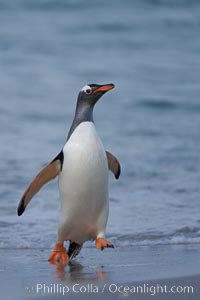
Gentoo penguin coming ashore, after foraging at sea, walking through ocean water as it wades onto a sand beach. Adult gentoo penguins grow to be 30" and 19lb in size. They feed on fish and crustaceans. Gentoo penguins reside in colonies well inland from the ocean, often formed of a circular collection of stones gathered by the penguins.
Species: Gentoo penguin, Pygoscelis papua
Location: New Island, Falkland Islands, United Kingdom
Image ID: 23841
Species: Gentoo penguin, Pygoscelis papua
Location: New Island, Falkland Islands, United Kingdom
Image ID: 23841
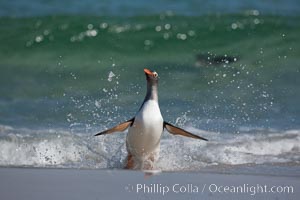
Gentoo penguin coming ashore, after foraging at sea, walking through ocean water as it wades onto a sand beach. Adult gentoo penguins grow to be 30" and 19lb in size. They feed on fish and crustaceans. Gentoo penguins reside in colonies well inland from the ocean, often formed of a circular collection of stones gathered by the penguins.
Species: Gentoo penguin, Pygoscelis papua
Location: New Island, Falkland Islands, United Kingdom
Image ID: 23845
Species: Gentoo penguin, Pygoscelis papua
Location: New Island, Falkland Islands, United Kingdom
Image ID: 23845
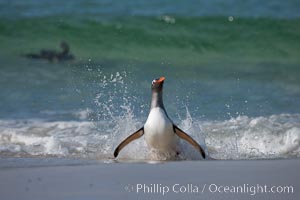
Gentoo penguin coming ashore, after foraging at sea, walking through ocean water as it wades onto a sand beach. Adult gentoo penguins grow to be 30" and 19lb in size. They feed on fish and crustaceans. Gentoo penguins reside in colonies well inland from the ocean, often formed of a circular collection of stones gathered by the penguins.
Species: Gentoo penguin, Pygoscelis papua
Location: New Island, Falkland Islands, United Kingdom
Image ID: 23850
Species: Gentoo penguin, Pygoscelis papua
Location: New Island, Falkland Islands, United Kingdom
Image ID: 23850
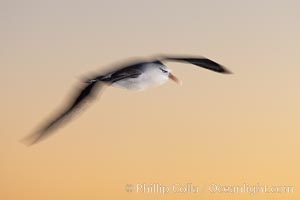
Black-browed albatross in flight, at sea. The black-browed albatross is a medium-sized seabird at 31-37" long with a 79-94" wingspan and an average weight of 6.4-10 lb. They have a natural lifespan exceeding 70 years. They breed on remote oceanic islands and are circumpolar, ranging throughout the Southern Ocean.
Species: Black-browed albatross, Thalassarche melanophrys
Location: Falkland Islands, United Kingdom
Image ID: 23965
Species: Black-browed albatross, Thalassarche melanophrys
Location: Falkland Islands, United Kingdom
Image ID: 23965
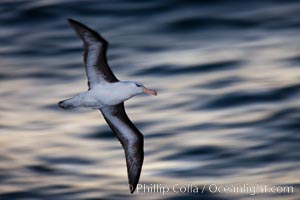
Black-browed albatross flying over the ocean, as it travels and forages for food at sea. The black-browed albatross is a medium-sized seabird at 31-37" long with a 79-94" wingspan and an average weight of 6.4-10 lb. They have a natural lifespan exceeding 70 years. They breed on remote oceanic islands and are circumpolar, ranging throughout the Southern Ocean.
Species: Black-browed albatross, Thalassarche melanophrys
Location: Falkland Islands, United Kingdom
Image ID: 23966
Species: Black-browed albatross, Thalassarche melanophrys
Location: Falkland Islands, United Kingdom
Image ID: 23966
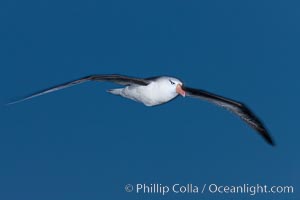
Black-browed albatross in flight, at sea. The black-browed albatross is a medium-sized seabird at 31-37" long with a 79-94" wingspan and an average weight of 6.4-10 lb. They have a natural lifespan exceeding 70 years. They breed on remote oceanic islands and are circumpolar, ranging throughout the Southern Ocean.
Species: Black-browed albatross, Thalassarche melanophrys
Location: Falkland Islands, United Kingdom
Image ID: 23978
Species: Black-browed albatross, Thalassarche melanophrys
Location: Falkland Islands, United Kingdom
Image ID: 23978
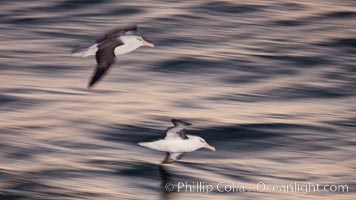
Two black-browed albatross flying over the ocean at night, travelling and foraging for food at sea. The black-browed albatross is a medium-sized seabird at 31-37" long with a 79-94" wingspan and an average weight of 6.4-10 lb. They have a natural lifespan exceeding 70 years. They breed on remote oceanic islands and are circumpolar, ranging throughout the Southern Ocean.
Species: Black-browed albatross, Thalassarche melanophrys
Location: Falkland Islands, United Kingdom
Image ID: 23979
Species: Black-browed albatross, Thalassarche melanophrys
Location: Falkland Islands, United Kingdom
Image ID: 23979
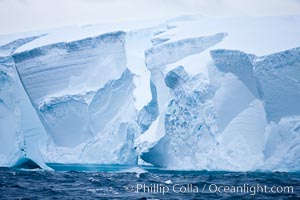
Tabular iceberg. The edge of a huge tabular iceberg. Tabular icebergs can be dozens or hundreds of miles in size, have flat tops and sheer sides.
Location: Scotia Sea, Southern Ocean
Image ID: 24793
Location: Scotia Sea, Southern Ocean
Image ID: 24793
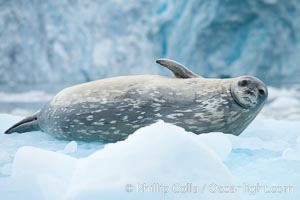
Weddell seal in Antarctica. The Weddell seal reaches sizes of 3m and 600 kg, and feeds on a variety of fish, krill, squid, cephalopods, crustaceans and penguins.
Species: Weddell seal, Leptonychotes weddellii
Location: Cierva Cove, Antarctic Peninsula, Antarctica
Image ID: 25501
Species: Weddell seal, Leptonychotes weddellii
Location: Cierva Cove, Antarctic Peninsula, Antarctica
Image ID: 25501
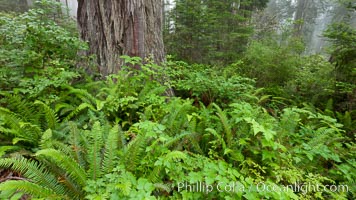
Ferns grow below coastal redwood and Douglas Fir trees, Lady Bird Johnson Grove, Redwood National Park. The coastal redwood, or simply 'redwood', is the tallest tree on Earth, reaching a height of 379' and living 3500 years or more. It is native to coastal California and the southwestern corner of Oregon within the United States, but most concentrated in Redwood National and State Parks in Northern California, found close to the coast where moisture and soil conditions can support its unique size and growth requirements.
Species: California redwood, Coast redwood, Giant redwood, Sequoia sempervirens
Location: Redwood National Park, California
Image ID: 25814
Species: California redwood, Coast redwood, Giant redwood, Sequoia sempervirens
Location: Redwood National Park, California
Image ID: 25814
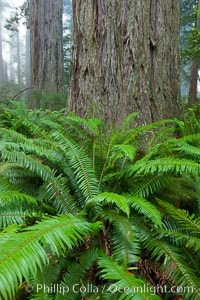
Ferns grow below coastal redwood and Douglas Fir trees, Lady Bird Johnson Grove, Redwood National Park. The coastal redwood, or simply 'redwood', is the tallest tree on Earth, reaching a height of 379' and living 3500 years or more. It is native to coastal California and the southwestern corner of Oregon within the United States, but most concentrated in Redwood National and State Parks in Northern California, found close to the coast where moisture and soil conditions can support its unique size and growth requirements.
Species: California redwood, Coast redwood, Giant redwood, Sequoia sempervirens
Location: Redwood National Park, California
Image ID: 25815
Species: California redwood, Coast redwood, Giant redwood, Sequoia sempervirens
Location: Redwood National Park, California
Image ID: 25815
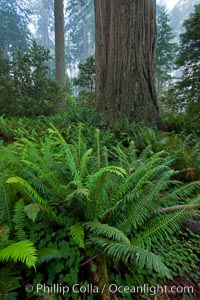
Coast redwood, or simply 'redwood', the tallest tree on Earth, reaching a height of 379' and living 3500 years or more. It is native to coastal California and the southwestern corner of Oregon within the United States, but most concentrated in Redwood National and State Parks in Northern California, found close to the coast where moisture and soil conditions can support its unique size and growth requirements.
Species: California redwood, Coast redwood, Giant redwood, Sequoia sempervirens
Location: Redwood National Park, California
Image ID: 25816
Species: California redwood, Coast redwood, Giant redwood, Sequoia sempervirens
Location: Redwood National Park, California
Image ID: 25816
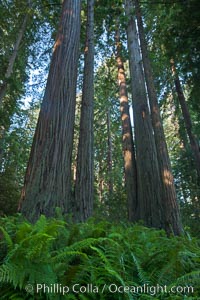
Coast redwood, or simply 'redwood', the tallest tree on Earth, reaching a height of 379' and living 3500 years or more. It is native to coastal California and the southwestern corner of Oregon within the United States, but most concentrated in Redwood National and State Parks in Northern California, found close to the coast where moisture and soil conditions can support its unique size and growth requirements.
Species: California redwood, Coast redwood, Giant redwood, Sequoia sempervirens
Location: Redwood National Park, California
Image ID: 25817
Species: California redwood, Coast redwood, Giant redwood, Sequoia sempervirens
Location: Redwood National Park, California
Image ID: 25817
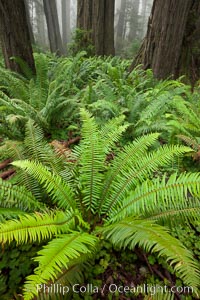
Ferns grow below coastal redwood and Douglas Fir trees, Lady Bird Johnson Grove, Redwood National Park. The coastal redwood, or simply 'redwood', is the tallest tree on Earth, reaching a height of 379' and living 3500 years or more. It is native to coastal California and the southwestern corner of Oregon within the United States, but most concentrated in Redwood National and State Parks in Northern California, found close to the coast where moisture and soil conditions can support its unique size and growth requirements.
Species: California redwood, Coast redwood, Giant redwood, Sequoia sempervirens
Location: Redwood National Park, California
Image ID: 25819
Species: California redwood, Coast redwood, Giant redwood, Sequoia sempervirens
Location: Redwood National Park, California
Image ID: 25819
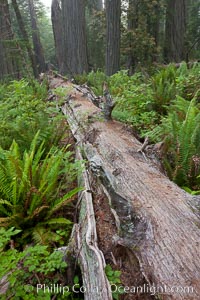
Fallen coast redwood tree. This tree will slowly decompose, providing a substrate and nutrition for new plants to grow and structure for small animals to use. Nurse log.
Species: California redwood, Coast redwood, Giant redwood, Sequoia sempervirens
Location: Redwood National Park, California
Image ID: 25820
Species: California redwood, Coast redwood, Giant redwood, Sequoia sempervirens
Location: Redwood National Park, California
Image ID: 25820
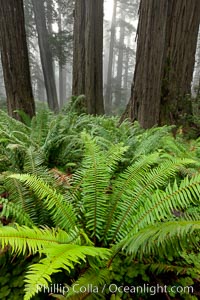
Ferns grow below coastal redwood and Douglas Fir trees, Lady Bird Johnson Grove, Redwood National Park. The coastal redwood, or simply 'redwood', is the tallest tree on Earth, reaching a height of 379' and living 3500 years or more. It is native to coastal California and the southwestern corner of Oregon within the United States, but most concentrated in Redwood National and State Parks in Northern California, found close to the coast where moisture and soil conditions can support its unique size and growth requirements.
Species: California redwood, Coast redwood, Giant redwood, Sequoia sempervirens
Location: Redwood National Park, California
Image ID: 25837
Species: California redwood, Coast redwood, Giant redwood, Sequoia sempervirens
Location: Redwood National Park, California
Image ID: 25837
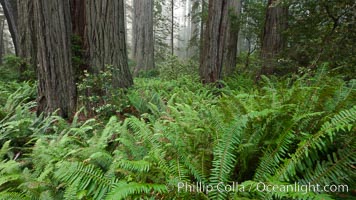
Giant redwood, Lady Bird Johnson Grove, Redwood National Park. The coastal redwood, or simply 'redwood', is the tallest tree on Earth, reaching a height of 379' and living 3500 years or more. It is native to coastal California and the southwestern corner of Oregon within the United States, but most concentrated in Redwood National and State Parks in Northern California, found close to the coast where moisture and soil conditions can support its unique size and growth requirements.
Species: California redwood, Coast redwood, Giant redwood, Sequoia sempervirens
Location: Redwood National Park, California
Image ID: 25844
Species: California redwood, Coast redwood, Giant redwood, Sequoia sempervirens
Location: Redwood National Park, California
Image ID: 25844
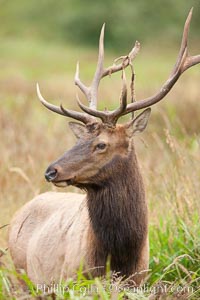
Roosevelt elk, adult bull male with large antlers. This bull elk has recently shed the velvet that covers its antlers. While an antler is growing, it is covered with highly vascular skin called velvet, which supplies oxygen and nutrients to the growing bone; once the antler has achieved its full size, the velvet is lost and the antler's bone dies. This dead bone structure is the mature antler, which is itself shed after each mating season. Roosevelt elk grow to 10' and 1300 lb, eating grasses, sedges and various berries, inhabiting the coastal rainforests of the Pacific Northwest.
Species: Roosevelt elk, Cervus canadensis roosevelti
Location: Redwood National Park, California
Image ID: 25892
Species: Roosevelt elk, Cervus canadensis roosevelti
Location: Redwood National Park, California
Image ID: 25892
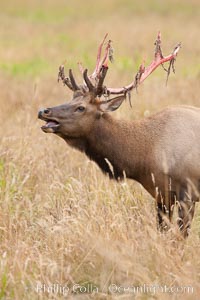
Roosevelt elk, adult bull male with large antlers. This bull elk has recently shed the velvet that covers its antlers. While an antler is growing, it is covered with highly vascular skin called velvet, which supplies oxygen and nutrients to the growing bone; once the antler has achieved its full size, the velvet is lost and the antler's bone dies. This dead bone structure is the mature antler, which is itself shed after each mating season. Roosevelt elk grow to 10' and 1300 lb, eating grasses, sedges and various berries, inhabiting the coastal rainforests of the Pacific Northwest.
Species: Roosevelt elk, Cervus canadensis roosevelti
Location: Redwood National Park, California
Image ID: 25895
Species: Roosevelt elk, Cervus canadensis roosevelti
Location: Redwood National Park, California
Image ID: 25895
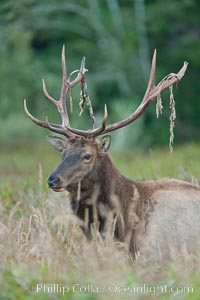
Roosevelt elk, adult bull male with large antlers. This bull elk has recently shed the velvet that covers its antlers. While an antler is growing, it is covered with highly vascular skin called velvet, which supplies oxygen and nutrients to the growing bone; once the antler has achieved its full size, the velvet is lost and the antler's bone dies. This dead bone structure is the mature antler, which is itself shed after each mating season. Roosevelt elk grow to 10' and 1300 lb, eating grasses, sedges and various berries, inhabiting the coastal rainforests of the Pacific Northwest.
Species: Roosevelt elk, Cervus canadensis roosevelti
Location: Redwood National Park, California
Image ID: 25900
Species: Roosevelt elk, Cervus canadensis roosevelti
Location: Redwood National Park, California
Image ID: 25900
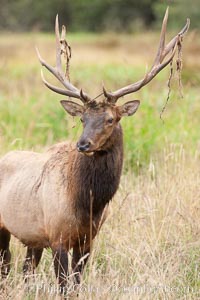
Roosevelt elk, adult bull male with large antlers. This bull elk has recently shed the velvet that covers its antlers. While an antler is growing, it is covered with highly vascular skin called velvet, which supplies oxygen and nutrients to the growing bone; once the antler has achieved its full size, the velvet is lost and the antler's bone dies. This dead bone structure is the mature antler, which is itself shed after each mating season. Roosevelt elk grow to 10' and 1300 lb, eating grasses, sedges and various berries, inhabiting the coastal rainforests of the Pacific Northwest.
Species: Roosevelt elk, Cervus canadensis roosevelti
Location: Redwood National Park, California
Image ID: 25906
Species: Roosevelt elk, Cervus canadensis roosevelti
Location: Redwood National Park, California
Image ID: 25906
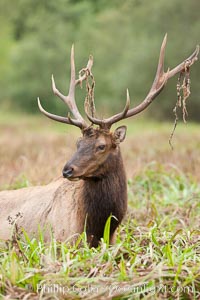
Roosevelt elk, adult bull male with large antlers. This bull elk has recently shed the velvet that covers its antlers. While an antler is growing, it is covered with highly vascular skin called velvet, which supplies oxygen and nutrients to the growing bone; once the antler has achieved its full size, the velvet is lost and the antler's bone dies. This dead bone structure is the mature antler, which is itself shed after each mating season. Roosevelt elk grow to 10' and 1300 lb, eating grasses, sedges and various berries, inhabiting the coastal rainforests of the Pacific Northwest.
Species: Roosevelt elk, Cervus canadensis roosevelti
Location: Redwood National Park, California
Image ID: 25910
Species: Roosevelt elk, Cervus canadensis roosevelti
Location: Redwood National Park, California
Image ID: 25910
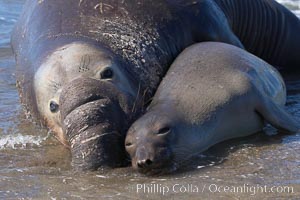
Elephant seals in the surf, showing extreme dimorphism, males (5000 lb) are triple the size of females (1700 lb). Central California.
Species: Elephant seal, Mirounga angustirostris
Location: Piedras Blancas, San Simeon, California
Image ID: 15497
Species: Elephant seal, Mirounga angustirostris
Location: Piedras Blancas, San Simeon, California
Image ID: 15497
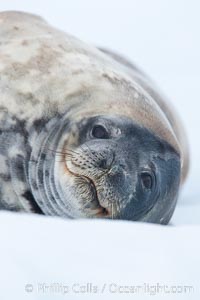
Weddell seal in Antarctica. The Weddell seal reaches sizes of 3m and 600 kg, and feeds on a variety of fish, krill, squid, cephalopods, crustaceans and penguins.
Species: Weddell seal, Leptonychotes weddellii
Location: Neko Harbor, Antarctic Peninsula, Antarctica
Image ID: 25661
Species: Weddell seal, Leptonychotes weddellii
Location: Neko Harbor, Antarctic Peninsula, Antarctica
Image ID: 25661
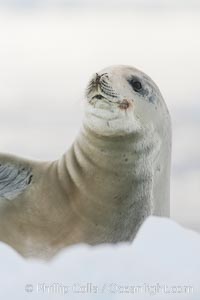
A crabeater seal, hauled out on pack ice to rest. Crabeater seals reach 2m and 200kg in size, with females being slightly larger than males. Crabeaters are the most abundant species of seal in the world, with as many as 75 million individuals. Despite its name, 80% the crabeater seal's diet consists of Antarctic krill. They have specially adapted teeth to strain the small krill from the water.
Species: Crabeater seal, Lobodon carcinophagus
Location: Neko Harbor, Antarctic Peninsula, Antarctica
Image ID: 25663
Species: Crabeater seal, Lobodon carcinophagus
Location: Neko Harbor, Antarctic Peninsula, Antarctica
Image ID: 25663
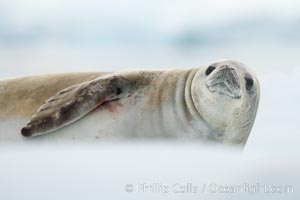
A crabeater seal, hauled out on pack ice to rest. Crabeater seals reach 2m and 200kg in size, with females being slightly larger than males. Crabeaters are the most abundant species of seal in the world, with as many as 75 million individuals. Despite its name, 80% the crabeater seal's diet consists of Antarctic krill. They have specially adapted teeth to strain the small krill from the water.
Species: Crabeater seal, Lobodon carcinophagus
Location: Neko Harbor, Antarctic Peninsula, Antarctica
Image ID: 25665
Species: Crabeater seal, Lobodon carcinophagus
Location: Neko Harbor, Antarctic Peninsula, Antarctica
Image ID: 25665
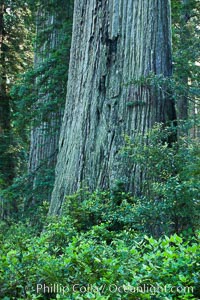
Coast redwood, or simply 'redwood', the tallest tree on Earth, reaching a height of 379' and living 3500 years or more. It is native to coastal California and the southwestern corner of Oregon within the United States, but most concentrated in Redwood National and State Parks in Northern California, found close to the coast where moisture and soil conditions can support its unique size and growth requirements.
Species: California redwood, Coast redwood, Giant redwood, Sequoia sempervirens
Location: Redwood National Park, California
Image ID: 25818
Species: California redwood, Coast redwood, Giant redwood, Sequoia sempervirens
Location: Redwood National Park, California
Image ID: 25818
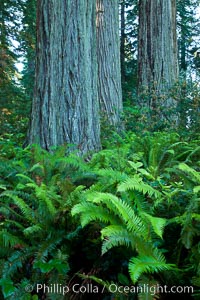
Ferns grow below coastal redwood and Douglas Fir trees, Lady Bird Johnson Grove, Redwood National Park. The coastal redwood, or simply 'redwood', is the tallest tree on Earth, reaching a height of 379' and living 3500 years or more. It is native to coastal California and the southwestern corner of Oregon within the United States, but most concentrated in Redwood National and State Parks in Northern California, found close to the coast where moisture and soil conditions can support its unique size and growth requirements.
Species: California redwood, Coast redwood, Giant redwood, Sequoia sempervirens
Location: Redwood National Park, California
Image ID: 25822
Species: California redwood, Coast redwood, Giant redwood, Sequoia sempervirens
Location: Redwood National Park, California
Image ID: 25822
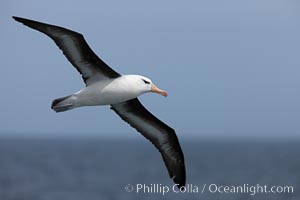
Black-browed albatross in flight. The black-browed albatross is a medium-sized seabird at 31-37" long with a 79-94" wingspan and an average weight of 6.4-10 lb. They have a natural lifespan exceeding 70 years. They breed on remote oceanic islands and are circumpolar, ranging throughout the Southern Ocean.
Species: Black-browed albatross, Thalassarche melanophrys
Location: Falkland Islands, United Kingdom
Image ID: 23716
Species: Black-browed albatross, Thalassarche melanophrys
Location: Falkland Islands, United Kingdom
Image ID: 23716
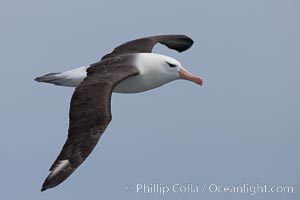
Black-browed albatross in flight. The black-browed albatross is a medium-sized seabird at 31-37" long with a 79-94" wingspan and an average weight of 6.4-10 lb. They have a natural lifespan exceeding 70 years. They breed on remote oceanic islands and are circumpolar, ranging throughout the Southern Ocean.
Species: Black-browed albatross, Thalassarche melanophrys
Location: Falkland Islands, United Kingdom
Image ID: 23717
Species: Black-browed albatross, Thalassarche melanophrys
Location: Falkland Islands, United Kingdom
Image ID: 23717